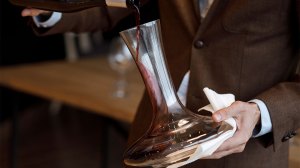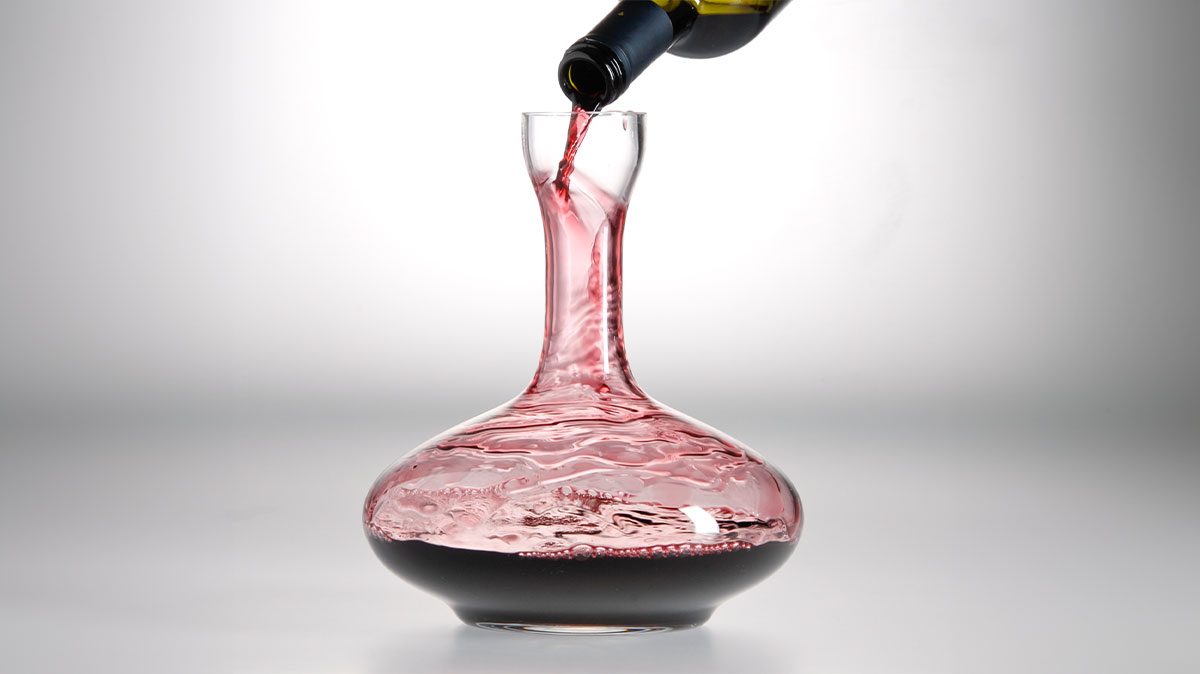This story is from an installment of The , our weekly insider newsletter to the world of fine wine.
To decant or not to decant is an oft-asked question, and there is a wide variety of opinions on the subject. When ordering certain bottles at particular establishments, a sommelier may automatically arrive tableside with a functional yet decorative crystal decanter, while on other occasions you may find yourself having to ask for this bump-up in service. are certainly not only for dining out; we have a few and use them regularly with many different wine styles. We spoke with some experts in the field to determine which wines need decanting, which ones don’t, and what style of decanter is the best to have.
When to Decant
“No wines require decanting,” says Dave Rudman, the newly minted partner and managing director at New York’s International Wine Center. That said, Rudman explains the three instances in which one would decant a wine. The first is to deliberately allow a wine to be in contact with oxygen. “This is done with young wines in order to allow them to release their aromas,” he says. The second is to separate a wine from any sediment in the bottle. “This is done mostly with older red wines, because over time harmless but unpleasant sediment will fall out of the wine and rest in the bottle,” he adds. Seemingly not a fan of decanters in general, Rudman posits that the third use for them is “for aesthetic or showmanship purposes only,” which is a controversial point of view.
The Science Behind Decanting
We often hear about “letting a wine breathe,” a process which introduces oxygen and accelerates the evaporation of volatile compounds, according to food scientists Heather Hyung Chang and Anthony Clark. “For aged wines that contain small amounts of negative sensory compounds, decanting allows the aeration of the wine to blow off highly volatile musty notes [due to] methional, mercaptans, and volatile acids,” Chang says. In addition to purifying the wine’s scent, it alters our sensory perception of the wine. “As these off-putting smells fade away, the more delicate aromatic elements take prominence, creating a cleaner and more inviting aroma experience,” Clark says.
At the same time, oxygenation is taking place; as the wine interacts with oxygen in the atmosphere, “it undergoes a transformation that alters its chemical makeup,” Chang says, which “facilitates the breakdown of certain compounds, softening tannins and freeing up various aromatic molecules.” At the same time, fruity esters such as ethyl acetate and isoamyl acetate are released, which enhance wine’s aroma. Meanwhile, exposure to oxygen encourages tannins in red wines to bind together, a process known as polymerization. “This chemical reaction can result in the sensation of a smoother palate, contributing to an overall improved mouthfeel experience,” Clark explains.
Decanting Older Wines

Mykhailo Lukashuk/Getty Images
One of the reasons that many of the older wines we’re still drinking hold up so well is that they “have been built to last,” explains Alex Cuper, wine director at Chicago’s and Brasero. These wines sit on the skin longer, have ample time to absorb barrel-derived tannins, and have higher acidity and alcohol. “Allowing more surface area allows these components to relax and integrate into the wine giving it a more balanced mouthfeel and overall drinkability,” he says. “Alcohol has a chance to evaporate out allowing the fruits to show more and integrate with the tannin and pH of the wine.”
At Pinch Chinese in New York, beverage manager Adrienne Cooper is concerned about sediment in older wines as well as bits of cork that may have broken away. “Most older wines won’t benefit from more oxygen, but they might have disintegrated cork bits or tartrates in the bottle,” which can be filtered out in the decanting process. An added benefit is the visual effect of the decanter. “It gives everyone an opportunity to see the color of the wine in volume, which will look slightly different in the glass,” she says.
Decanting Young Wines
Although he believes a very small percentage of young wines need to be decanted, Rudman says that “any wine that is age-worthy in the bottle is a candidate for decanting while young, because the rapid aeration does in minutes or hours what the slow oxidation of bottle aging would accomplish over years.” Luke Boland, corporate beverage director for Hospitality Department in New York City, uses decanters for very young reds, and he is particular about the method he uses. “In this case, almost a violent, inverted decant to get as much air pumped into the juice as it glugs out of the bottle,” he says, explaining that this will soften the structure a bit, especially if the wine feels “tight, overly tannic, or grippy.”
As Kyle Davidson, corporate beverage director of Chicago’s Day Off Group, which operates and Il Carciofo, says, young wines “have their whole lives ahead of them and we’re trying to get them to tell their story on an expedited timeline.” With that in mind, he hopes that when serving a tannic wine, such as young Barolo, “some fruit and perfume will come out to balance” the wine’s harsher aspects.
Decanting Whites
While we often only think of decanting reds, everyone we spoke with uses the process for whites as well. Boland decants whites from Germany, Austria, Burgundy, Italy, and Spain, because the process “can help the ‘matchstick, smoke, gun powder’ kind of smells that young white wine can have if it’s made in a reductive style.” White wines also benefit from time spent in decanter on the table, especially if they are served cold and have an opportunity to come up toward room temperature. Davidson prefers to decant whites that have spent some time on the lees or in oak or those that have a viscous, waxy texture, but more than that, he says, “I like not only the oxygen but also the temperature progression that a decanter offers.”
Decanting Bubbles
Should you decant Champagne? Cooper points out that although it’s currently trendy to do so, she’s not a fan. “Part of the allure of Champagne is those tiny bubbles,” she says, adding “If I’m paying for a wine with bubbles, then I don’t want to drink a wine that is flat.” Rudman says, “Go for it if you want. But you’ll lose your bubbles.” Ever diplomatic, Boland will decant Champagne per client request, but that it must be done gently, “to preserve the bubbles.”
What Style of Decanter Is Best?

Maximilian Riedel
Sommeliers look to the practical aspects, shapes that are relatively easy to clean and dry, base-to-spout ratio that doesn’t require two hands or complete inversion to get the last drop, and sizes that don’t compromise too much tabletop real estate, which is more of an issue in a restaurant than at home. “I love how many different shapes there are and that they can double as art pieces for your home,” says Cooper, who pulls out the pretty ones for company but will use a straight cylinder if she’s pouring for just herself. Cuper likes a decanter with a wide, round base, “almost like a flying saucer shape,” because they are easy to pour and are best for visualizing sediment. Due to the large size of this style, he often uses an amphora-shaped decanter that offers good surface area and also allows him to pull out sediment. We spoke to the one person in the world who no doubt knows more about decanters than anyone, Maximilian Riedel, 11th generation CEO and president of , the Austrian glassware firm known for its variety-specific crystal stemware. For those who do not have an extensive wine collection but want to have one decanter at home, Riedel recommends either the classic Riedel Decanter or the new Fatto a Mano model, both of which are “straightforward to use and easily stored.” He mentions a family friend who runs a restaurant near Kufstein, Austria, who owns and uses a collection that includes every model they have produced, which puts our paltry collection of 10 to shame.
Should I Decant?
In the end, it’s up to you, but having a handle on the science and styles of wine that may need it certainly helps. Some of our experts have concerns about older, very delicate wines. However, they will use a decanter if that is what the customer desires and will normally pour an un-decanted taste first and see if the client still feels that they want to go ahead with it. “Ultimately, the art of decanting is a journey that merges psychological delight with sensory exploration,” Chang says. “It transforms the act of drinking into an experience, inviting you to take the time to appreciate the subtle nuances and transformations happening in your glass.” Rudman takes a more down-to-earth view: “There’s no question it is more of a baller move to serve wine from a Dale Chihuly than it is from a bottle.”
Do you want access to rare and outstanding reds from Napa Valley? .
Authors
-
Mike DeSimone and Jeff Jenssen
Mike DeSimone and Jeff Jenssen, also known as the World Wine Guys, are wine, spirits, food, and travel writers, educators, and hosts. They have been featured guests on the Today Show, The Martha…
Credit: robbreport.com











